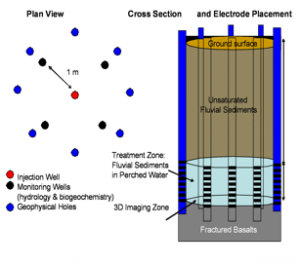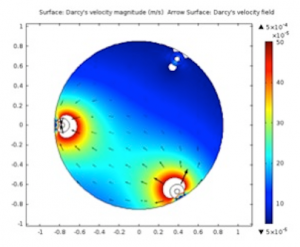Microbially-Induced Calcite Precipitation
Current Funding: NSF/CMMI, Bio-Cementation Field-Scale Trials: Addressing the Challenges of Treatment Unformity & Verification, Biostimulation, & By-Product Management, (co-PI with J. DeJong/UCDavis), $596,646, 2012-2015.
Students Mohamed Nassar, Mehrdad Bastani, Titus Garrett.
Collaborators: J. DeJong, Doug Nelson, UC Davis; Bob Smith Idaho National Lab.
Project Summary. Bio-mediated soil improvement, and in particular the use of microbially induced calcite precipitation (MICP) as a natural bio-mediated cementation process for sand improvement, has progressed rapidly. Recent field implementations have revealed critical issues regarding treatment uniformity and verification, bio-stimulation, and by-product management. We directly address these issues through modest field-scale trials supported by experimental and numerical modeling. In this project we perform two field-scale trials in an embedded 6.7 m diameter by 5.5 m deep test chamber using natural liquefiable sand.
Plan and section view of 5-spot treatment. Color schematic of treatment solution flow rates.
The first trial relies on bio-augmentation (injection of bacteria) in order to provide a low-risk ground-truth set of data unencumbered by the unknown spatial distribution of native bacteria that we face with bio- stimulation. The second trial will use bio-stimulation (activation of native sessile bacteria) that introduces the additional degree of freedom (spatial distribution of bacteria) but is also the most desirable field scale treatment approach for the future. It is more practical (cost, permitting), has reduced by-product generation, and may increase uniformity. Both trials will enable study of by-product generation during treatment and its fate after soil improvement. Treatment will occur using a 3 well pattern as shown above, with iterated dipole pumping between sequential pairs of wells. The full-scale work is supported by parallel efforts developing a robust bio-stimulation technique and modeling of the field trials to develop a predictive modeling tool that accounts for bio-stimulation, by-product transport and fate, and spatial heterogeneity.
Important papers on the topic:
- DeJong, J. T., B. C. Martinez, T. R. Ginn, C. Hunt, D. Major, and B. Tanyu, Development of a scaled repeated five-spot treatment model for examining microbial induced calcite precipitation feasibility in field applications, Geotechnical Testing Journal 37(3), 2014.
- Martinez, B. C., J. T. DeJong, T. R. Ginn, Bio-geochemical reactive transport modeling of microbial induced calcite precipitation to predict the treatment of sand in one-dimensional flow, Computers & Geotechnics, 58:1-13, 2014.
- Martinez, B. C., J. T. DeJong, T. R. Ginn, B. Montoya, T. H. Barkouki, C. Hunt, B. Tanyu, and D. Major, Experimental optimization of microbial-induced carbonate precipitation for soil improvement, J. Geotechnical and Geoenv. Eng. 139(4):587-598, 2013.
- Barkouki, T.H., Martinez, B.C., Mortensen, B.M., Weathers, T.S., De Jong, J.D., Ginn, T.R., Spycher, N.F., Smith, R.W., Fujita, Y., Forward and Inverse Bio-Geochemical Modeling of Microbially Induced Calcite Precipitation in Half-Meter Column Experiments, Transport in Porous Media, 90(1):23-39, 2011.
- DeJong, J.T., Soga, K., Banwart, S.A., Whalley, W.R., Ginn, T.R., Nelson, D.C., Mortensen, B.M., Martinez, B.C., Barkouki, T., Soil engineering in vivo: Harnessing natural biogeochemical systems for sustainable, multi-functional engineering solutions, J. Royal Society Interface, 8(54):1-15, 2011.







